Hubspot and Smart Insights released an eBook about the use of content marketing in Europe. “Driving Content Marketing Success in 2014” provides advice and data, the latter based on a survey that was completed in December 2013. The eBook also offers insights from guest commenters and our good friend Dave Chaffey, the man behind many books, reports and must-check online resource, Smart Insights.
In a December 2013 Smart Insights poll, content marketing was rated as the the most important trend based on what the 637 respondents (client-side and agency-side) considered to make the biggest commercial difference to leads or sales (29.2% of respondents). Also noteworthy in this poll: the place of conversion rate optimization and marketing automation, both poised to grow and, as Dave writes in his blog post, about process and improving performance.
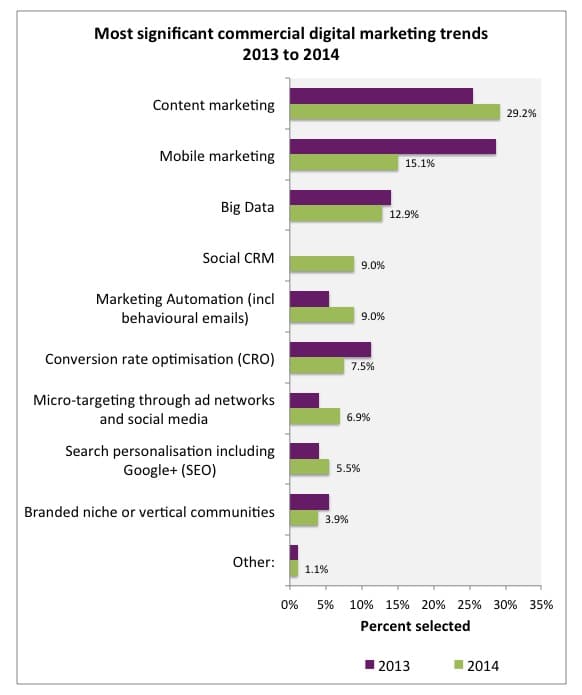
Back to the Hubspot and Smart Insights eBook and research. An overview of some numbers and comments.
The adoption of content marketing
First takeaway: the majority of respondents (36%) has an inconsistent approach regarding content marketing with a lack of integration and 20% makes basic use of content marketing (some investment, no senior management buy-in). After having removed the N/A answers, Hubspot concludes that “71% of companies’ adoption of content marketing has been inconsistent or worse”.
According to commenter Annmarie Hanlon of Evonomie, also a regular contributor to Smart Insights, the greatest challenge for content marketing is often in the boardroom. Annmarie recommends, I quote, “using Google Analytics or your analytics tool to show the volume of traffic completing an action, driven from your content sources”. This allows you to “gather an evidence base to convince the senior team“.
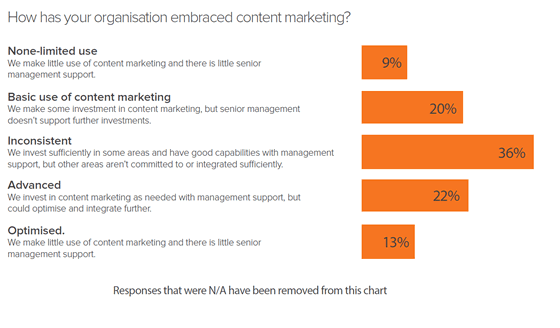
In order to move beyond the first and essential steps of content marketing, buy-in for a more advanced use of content in a broader, integrated context is indeed crucial. And convincing the C-suite is often a matter of numbers, even if demand for better content strategies increasingly comes from “the top” as well.
Content marketing runs like a thread through a connected and integrated marketing approach, as I “say” in the eBook. Few companies today have that integrated approach around a single customer view as it requires change of culture and processes. This clearly has an impact on the use of content for marketing purposes across the customer life cycle (also beyond digital of course).
Content marketing spend
After having removed N/A responses, the majority (49%) of respondents is investing anywhere between 0 and 20% of the marketing budget on content marketing. Taking into account that content marketing is an umbrella term and that the awareness regarding content marketing is not as high as in the US where the term was coined, it’s not surprising reported content marketing budgets are low.
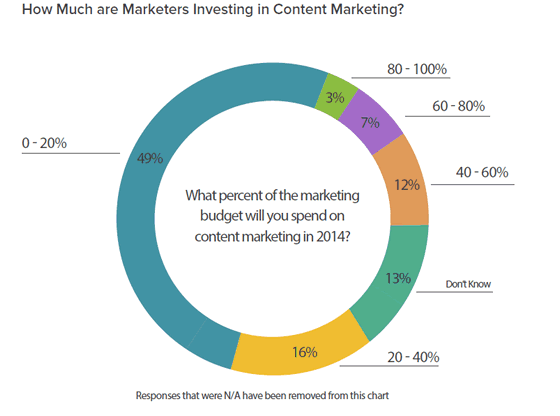
However, it also is related to a lack of an integrated and customer-centric view in which content intervenes at multiple levels, which is a more universal phenomenon. And in some regions, industries and types of businesses across Europe there is indeed a later “adoption”. It’s clear that content marketing is on the rise in Europe but it’s not easy to draw general conclusions as many organizations are “doing” content marketing without knowing the term as I noticed at several occasions. Furthermore, “Europe” is a very heterogeneous market.
In that sense, I was surprised to see a Mashable post in which the author used a Google search as a parameter to see in which degree content marketing is adopted across Europe. I quote: “When you Google “content marketing in Europe,” you get a rather small 178 million returns with very little in the way of best practices, stats and developed content. Now, the same search with “in US” at the end garners 748 million returns with lots of rich content results”.
Curiosity might be location-agnostic but terminology isn’t and I don’t think that Europeans who know the term content marketing and are interested in it, often type in the search term “content marketing in Europe” in Google. I would expect non-European companies offering content services and tools do that more when they want to expand, for instance. Most research on content marketing in Europe has been looking at the state of content marketing in the UK for many self-explanatory reasons. It’s also pretty obvious that this is where the term is used most often.
Just to give you an idea about the flaw in the reasoning: look up ‘marketing de contenu’ (French) in Google. That’s another million search results. Now do all other languages (“marketing de contenidos”: 8 million results but also South America). Finally, note that in one of the countries where content marketing is most adopted (The Netherlands) content marketing is written in one word as contentmarketing (and in Belgian Dutch it depends). Can you still follow? Let’s not even start with the Nordics etc.
Again: do take into account that there are most certainly industries, organizations and even countries where the use of content marketing is far more mature than in others and keep in mind that there is no such thing as the ‘European marketer’.
Content sourcing
According to the research, marketers are investing their budget in creating an internal content team vs using an external resource, with 55% of marketers increasing their spend on internal headcount in 2014 and 40% increasing investment in external content creation.
The debate regarding outsourcing content creation or doing it in house is not an easy one. While the brand narrative, the industry, the customers, the products and solutions (and the reasons they were developed) and often the know-how of the customer needs and preferences are better known in the company, this doesn’t mean that in-house is better in general. It’s not really this versus that either.
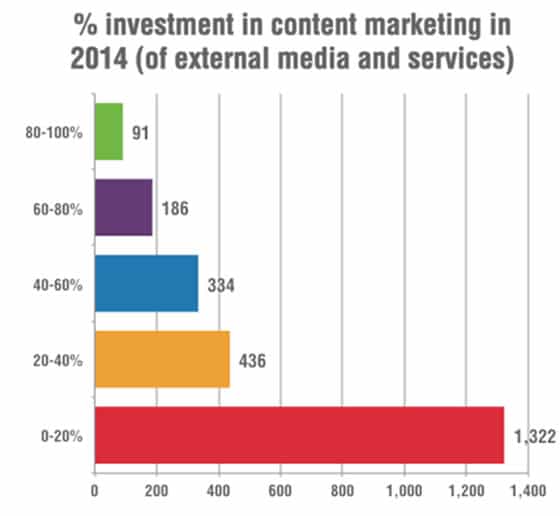
In most cases I advise organizations to get an external partner on board in the beginning, certainly beyond the narrow scope of content creation. However, this partner ideally knows the company inside-out, conducts customer interviews and transfers knowledge and skills in order to empower a growing internal headcount. In my experience, a Center of Excellence (CoE) often works well in this regard as content marketing is typically a horizontal strategic and tactical approach. It runs across divisions and includes multiple stakeholders. A (temporary) CoE can make this happen, with a strong partner and clear training program. When the opportunity is there to increase headcount, the role of the CoE can become unnecessary and the partner can be involved less. However, content marketing is not always easy and possible without a partner, when seen as a continuous effort and, depending on the company, industry, business context, people and so much more.
Expert comment from Kevin Sutherland, Strategy Director at Seven: “When developing an internal resource, success depends on whether the company can attract, motivate, and retain an editorial team. There is a big question for brands about who they should trust to make the most of the content marketing opportunity. Naturally, we would say that the best partner is an editorial expert who only ‘does’ content and whose primary concern is your brand and your audience, not theirs”.
Content strategy
Creating and implementing a content strategy is pivotal to seeing success with content marketing, the eBook says. It’s the famous need for (and lack of) a decent strategy issue, that is increasingly emphasized. However, most respondents do recognize the need of a decent content (marketing) strategy and 58% found their content to be much more effective with a content strategy in place.
My advice to marketers struggling with implementing successful inbound content marketing is simple: Start planning, and stop feeling that you’ve got to get your next piece out. (Stephen Bateman, Concentric Dots)
Having a solid and realistic strategy that makes sure all content needs are covered and gradually grows beyond the pure essential needs makes a huge difference. Without a content strategy, content marketing simply doesn’t work. However, I fear that the lack of a strategic view plays on multiple levels though and is a sign that many organizations still don’t ask the right questions: what do I need when and where in order to create value for prospects, customers and their ecosystem and, by doing so, create value for my business? Content marketing is for the long term and requires an integrated marketing strategy. This is not just a challenge for content marketing by the way.
Content marketing challenges

The report also identified some major content marketing challenges (see SlideShare below). And here we quote Dave Chaffey from Smart Insights: “It’s no surprise to see the “Usual Suspects” challenges of content quality, content frequency and measurement rated as significant challenges. We were pleased to see content strategy also highly rated as a challenge since this is the secret to managing many of these other challenges successfully! Of the other success factors mentioned as challenges, budget, making the case and skills were less significant, suggesting that many organizations have been successful in identifying budget and resource”.
Finally, here’s a graphic on the effectiveness of content marketing formats shows that blogging and newsletters are more used than many of the different other formats and channels that exist.
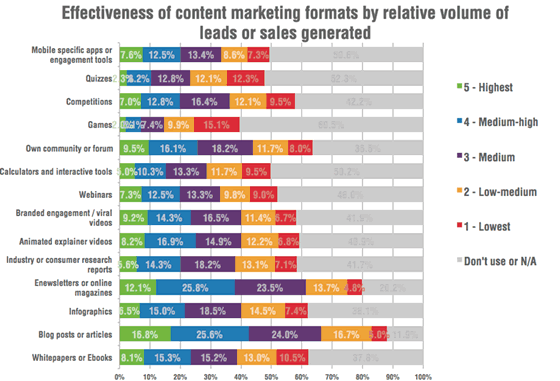
Blogging is the core of any content marketing program – but it’s often not the thing that generates leads directly. It tends to be higher in the funnel, leading folks towards content that is more likely to generate a lead. Marketing automation helps you build an attribution model that will show the value of a blog even if it’s not the number one lead generator. (Doug Kessler, Velocity Partners)
Check out the SlideShare below for more stats and find more data and comments/insights from Doug Kessler (Velocity Partners), James Carson (Carson Content), Stephen Bateman (Concentric Dots) and Daniel Rowles (Target Internet) in the PDF (registration required).

